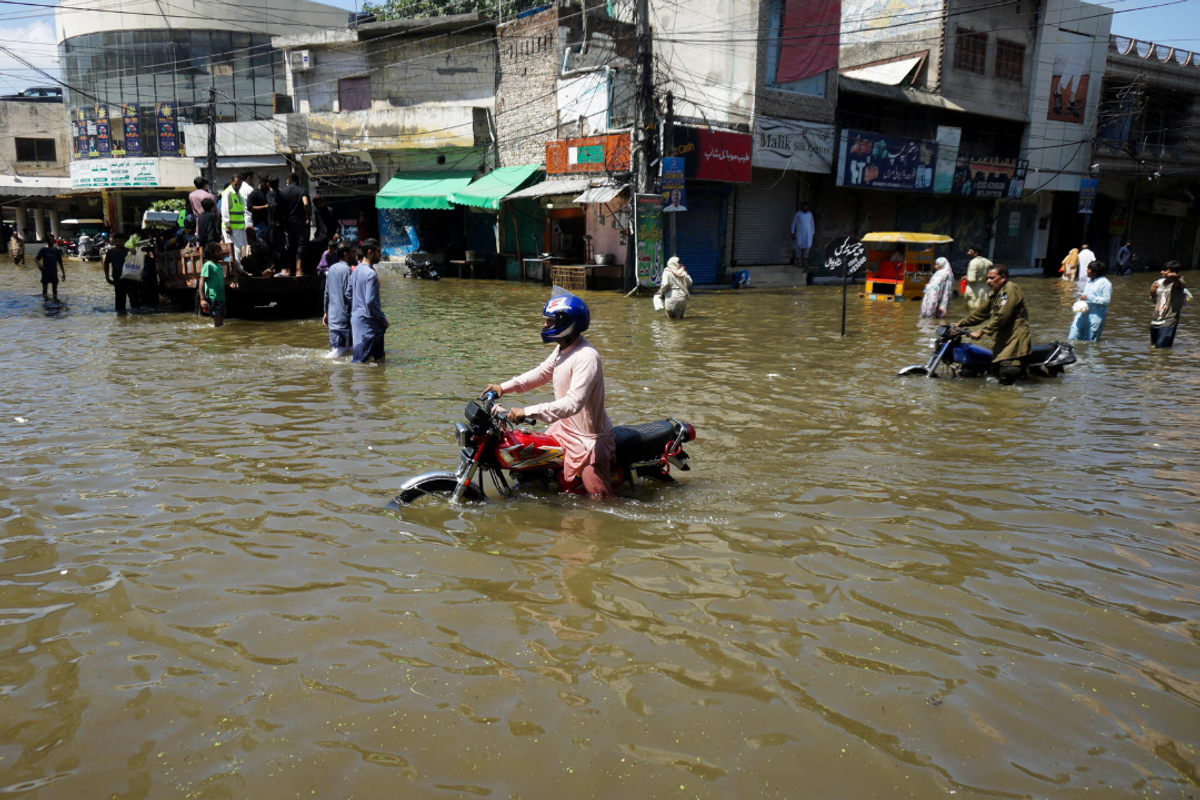Pakistan floods seen widening FY26 current account deficit by USD 1.9B
Cotton imports, weaker textile and rice exports to strain trade balance
Business Desk
The Business Desk tracks economic trends, market movements, and business developments, offering analysis of both local and global financial news.

Vehicles move along a flooded road following monsoon rains and rising water levels of the Chenab River, in Gujrat, Punjab province, Pakistan
Reuters
The economic shockwaves from this year’s floods are expected to stretch far beyond damaged fields and broken roads, with Pakistan’s current account deficit projected to widen by approximately USD 1.93 billion in FY26, according to estimates by Arif Habib Ltd. (AHL).
The investment and research firm warns that the country’s trade balance will take a significant hit as both import bills and export revenues shift unfavorably due to widespread agricultural losses.
“The most notable pressure is expected from cotton, where domestic shortfalls could push imports up by 737,000 tons, costing about USD 1.06 billion,” AHL said in its report. “This reflects the textile sector’s dependence on cotton and highlights the risks that supply disruptions pose for the country’s largest export-oriented industry.”
On the export side, key agricultural commodities are also expected to underperform. Textile exports could fall by around USD 300 million, while rice and sugar exports are projected to decline by USD 278 million and USD 283 million, respectively. This brings total projected export losses to nearly USD 861 million.
“The combined effect of higher cotton imports and weaker exports in textiles, rice, and sugar would therefore amount to a trade balance impact of around USD 1.93 billion in FY26,” the report noted. “While this figure may not seem large compared to Pakistan’s overall trade deficit, the concentration of losses in key sectors is meaningful.”
AHL emphasized that these sectors—particularly textiles and rice—are critical foreign exchange earners and serve as buffers against external imbalances.
Food inflation looms
As agricultural supply chains reel from the flood impact, the risk of food-driven inflation is intensifying. AHL revised its average inflation forecast for FY26 to 7.2%, up from the pre-flood estimate of 5.5%.
“Meat, rice, vegetables, and sugar collectively carry a weight of around 20% in the CPI basket,” the firm stated. “Shortages in these items are therefore likely to fuel a price spike.”
Early indicators suggest price pressure is already building. The Sensitive Price Index (SPI) for the first week of September showed sharp month-on-month increases in wheat, tomatoes, onions, and other vegetables, with food inflation projected to rise by 4.3% for the month, its highest pace since July 2024.
Drawing parallels to past crises, AHL noted that food inflation averaged 14.4% year-on-year during the first half of FY11 following the 2010 floods, and surged to 27.9% in the same period of FY23 after the 2022 floods.
Fiscal strain mounts
On the fiscal front, reconstruction and rehabilitation efforts are expected to cost at least PKR 107 billion (USD 364 million), according to AHL. This estimate excludes agricultural and livestock-related support, suggesting the eventual cost could be much higher.
“With major infrastructure destroyed, people displaced and on the verge of starvation, immediate disbursements will have to be made for temporary rehabilitation and food distribution,” the report said.
Roads and bridges—critical for relief logistics and trade—make up the largest portion of the estimated cost, with over PKR 97.6 billion (USD 333 million) in damages. Housing damages, affecting around 9,000 households, add another PKR 9 billion (USD 31 million) to the bill.
AHL also warned that agriculture losses amounting to PKR 302 billion (USD 1.03 billion) will likely push fiscal costs higher through subsidies, credit support for farmers, and possible concessional imports of wheat, rice, and cotton.
“Relief measures for livestock owners, despite the smaller aggregate loss of PKR 0.5 billion, will remain important given the role of livestock in rural livelihoods,” the firm added.
To bridge the financing gap, AHL anticipates the need for supplementary budget allocations or a reprioritization of development spending under the FY26 Public Sector Development Program (currently budgeted at PKR 1 trillion). Greater reliance on multilateral and bilateral financing is also likely.










Comments
See what people are discussing